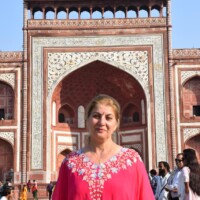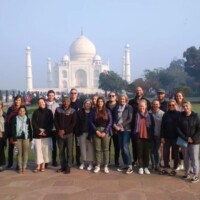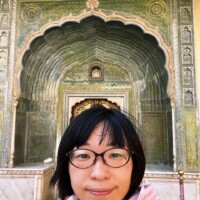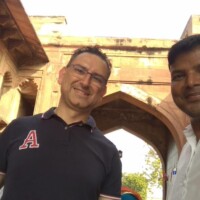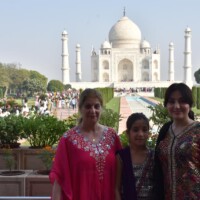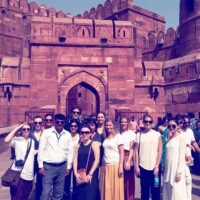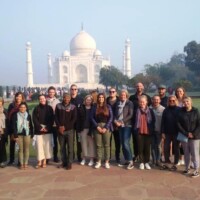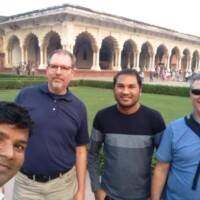A Journey Through Agra in India: Conversations with the Mughals
In the heart of Agra in India, where history breathes through the very stones, three legendary figures gathered beneath the vibrant hues of an evening sky. The sun dipped low, casting a golden glow on the majestic monuments that surrounded them. This city, renowned for its rich heritage and architectural splendour, had witnessed the rise and fall of empires. As the shadows lengthened across the grounds of the Red Fort, Babur, Akbar, and Shah Jahan exchanged stories and reflections on their legacies.
The Red Fort: A Fortification of Dreams
Babur, the founder of the Mughal Empire, stood proudly on the ramparts of the fort. He gazed at the sprawling city beneath him, filled with bustling markets and vibrant life.
“Ah, Agra in India!” he exclaimed. “When I arrived here, I saw not just land but a canvas waiting for my vision. My journey was fraught with challenges, yet every struggle forged my resolve.”
Babur had faced significant political instability during his ascent to power. The First Battle of Panipat in 1526 marked a turning point; it was here that he defeated Ibrahim Lodi, ending the Delhi Sultanate’s rule and establishing the Mughal Empire. His military tactics, including the use of artillery and cavalry, were revolutionary for that time.
Akbar, his grandson, joined him, leaning against the cool stone walls. “Indeed, grandfather. You laid the foundation for something magnificent. However, it is our duty to nurture this dream further.”
During Akbar’s reign, he faced challenges that included consolidating power over a diverse empire. He introduced the Mansabdari system, which structured the military and administrative framework. This system allowed him to effectively manage a vast territory while promoting meritocracy within his ranks.
As they conversed, Shah Jahan approached, a playful grin on his face. “And perhaps,” he said, “it falls to me to create beauty from your dreams! Look at the Taj Mahal; it shall stand as a testament to love and artistry!”
“In Agra, a beauty shines bright,
With marble that dazzles at night.
Though love’s a grand scheme,
It’s built on a dream,
In its shadows, our hearts take flight.”
The three shared a hearty laugh, their camaraderie reflecting the spirit of unity that defined their reigns.
Fatehpur Sikri: The City of Victory
Their conversation soon turned towards Fatehpur Sikri, Akbar’s magnificent city of victory. The trio made their way to the grand Buland Darwaza, an imposing gateway adorned with intricate carvings and vibrant tiles.
“This is not merely a door,” Akbar declared, his voice echoing against the archways. “It represents my commitment to justice and inclusivity.”
Akbar’s reign was notable for its efforts in promoting religious tolerance and unifying diverse cultures within his empire. He established a forum for discussion among different religious leaders at the Ibadat Khana, showcasing his belief in pluralism. He sought to bring together not just Muslims but also Hindus, Christians, and others, fostering an environment where ideas could flourish.
Babur nodded in agreement. “You have transformed this land into a sanctuary for all faiths. I admire your vision, Akbar.”
Shah Jahan added, “Yes! But let us not forget that beauty lies in every corner of our empire. The architecture here is a marriage of function and elegance.”
As they walked through the vast courtyards, they observed how each pillar told a story of its own. The echoes of scholars discussing philosophy and art filled their minds with inspiration. The intricate designs and grand scale of Fatehpur Sikri were testaments to Akbar’s vision of an empire that celebrated diversity.
“Though victory may bring us great fame,
It’s love and respect that stake our claim.
In Fatehpur’s embrace,
We honour each face,
For unity’s light is our aim.”
The Taj Mahal: A Monument of Love
Next, they journeyed to the banks of the Yamuna River to behold the breathtaking Taj Mahal. The moonlight caressed its marble surface, revealing its ethereal beauty. Shah Jahan’s eyes sparkled with pride.
“This is my heart laid bare,” he said softly. “Every marble slab tells the story of my love for Mumtaz Mahal.”
Shah Jahan commissioned the Taj Mahal as a mausoleum for his beloved wife in 1632. It took over twenty years to complete and involved thousands of artisans and craftsmen from various regions. The architectural innovations employed in its construction—such as the use of white marble inlaid semi-precious stones—demonstrate the height of Mughal artistry.
Babur observed the monument with admiration. “Your dedication to beauty is awe-inspiring! It transcends time and space.”
Akbar chimed in, “Indeed! The Taj Mahal stands as a beacon of what we can achieve when we pour our hearts into our creations.”
They stood in silence for a moment, allowing the serenity of the moment to envelop them. The reflection in the water mirrored their thoughts—a blend of love and loss.
Shah Jahan spoke again, breaking the stillness. “Let us remember that beauty is not simply found in grand structures but also in the relationships we cultivate.”
While Shah Jahan’s reign was marked by architectural achievements, it also faced challenges such as revolts and opposition from powerful nobles who sought to undermine his authority. Nonetheless, his commitment to art and culture remained unwavering.
“In Agra shines a tale so rare,
Of love that conquers dark despair.
With every stone laid fine,
A heart did intertwine,
A promise held in timeless care.”
Reflections on Legacy: A Lesson from History
As twilight deepened into night, the three emperors reflected on their legacies. They knew that their stories would echo through time—woven into the fabric of Agra in India.
“Future generations will walk these paths,” Babur mused. “They will study our lives and learn from our triumphs and failures.”
“Yes,” Akbar replied thoughtfully. “We must inspire them to embrace diversity and foster understanding among all peoples. Perhaps I should guide them through this journey as I once did at the Delhi gate of Agra Fort.”
Shah Jahan added with a smile, “And let them know that love is a powerful force—one that can shape empires and create enduring beauty.”
With that thought lingering in the air, they recited a couplet inspired by Shakespeare:
“For love’s true essence doth inspire,
In marble dreams we find our fire.”
As they prepared to depart from this sacred place filled with memories and monuments, a sense of fulfilment washed over them. Their spirits would forever remain intertwined with Agra’s history.
Conclusion: A Legacy Beyond Time
Today, visitors flock to this remarkable city, eager to explore its treasures. They seek Taj Mahal tour packages that promise an experience steeped in history and romance. Agra in India continues to captivate hearts and minds alike.
In this city where three emperors once walked, history breathes anew with every footstep taken on its ancient paths. Each monument whispers tales of love and ambition—an enduring reminder that legacies are built not just with bricks and mortar but through passion and purpose.
Historical Context: A Broader Perspective
The story of Agra is not merely about magnificent structures; it encapsulates centuries of cultural evolution and socio-political dynamics that shaped modern India.
Political Landscape
Under Babur’s rule, India was fragmented into many small kingdoms with varying degrees of power. His successful campaign against Ibrahim Lodi at Panipat not only paved his way to establish Mughal dominance but also set a precedent for future conquests by other Mughal emperors.
Akbar’s Reforms
Akbar’s reign marked a significant turning point due to his focus on administrative reforms aimed at consolidating Mughal power over diverse populations. His establishment of various councils allowed local leaders to have a voice while ensuring loyalty to central authority.
Moreover, Akbar’s marriage alliances were pivotal in forging strong ties with Rajputana—a crucial step toward unifying India under Mughal rule.
Cultural Dynamics
The Mughal Empire was known for its remarkable cultural synthesis; it brought together Persian art influences while integrating local Indian traditions. This is evident in Fatehpur Sikri’s architecture featuring intricate carvings that reflect both Islamic motifs and Hindu artistry.
Social Issues
During this time, women began to assert their influence more than ever before in Mughal society. Figures like Nur Jahan demonstrated political acumen by influencing decisions during her husband Jahangir’s reign—reminding us that women’s voices contributed significantly to history.
Technological Advancements
Architectural innovations were crucial during this period; new techniques allowed structures like the Taj Mahal to reach unprecedented heights of beauty and complexity. Techniques such as dome construction emerged from earlier Persian influences blended with local craftsmanship skills.
Significant Events
A series of rebellions marked Shah Jahan’s later reign—most notably led by his own son Aurangzeb—who would eventually dethrone him. This transition highlights how dynastic struggles often overshadowed earlier achievements.
Final Thoughts: A Tapestry of Heritage
Agra stands today as more than just home to historical monuments; it embodies centuries worth of stories interwoven through conflicts fought over ideals ranging from love to power. Visitors who walk these revered grounds are invited not only to witness architectural marvels but also engage with an illustrious past filled with lessons relevant even today.
Disclaimer: The narrative presented above is a fictional recreation of historical events and figures. While it draws inspiration from real historical contexts and monuments in Agra, India, the dialogues and interactions between Babur, Akbar, and Shah Jahan are imaginative interpretations intended for storytelling purposes. Any resemblance to actual events or persons, living or dead, is purely coincidental. Furthermore, there is no intention to offend any individual or group, and the portrayal aims to celebrate the rich cultural heritage of Agra. We have the utmost respect for all cultures and people and will happily correct any mistakes if they are brought to our attention.





